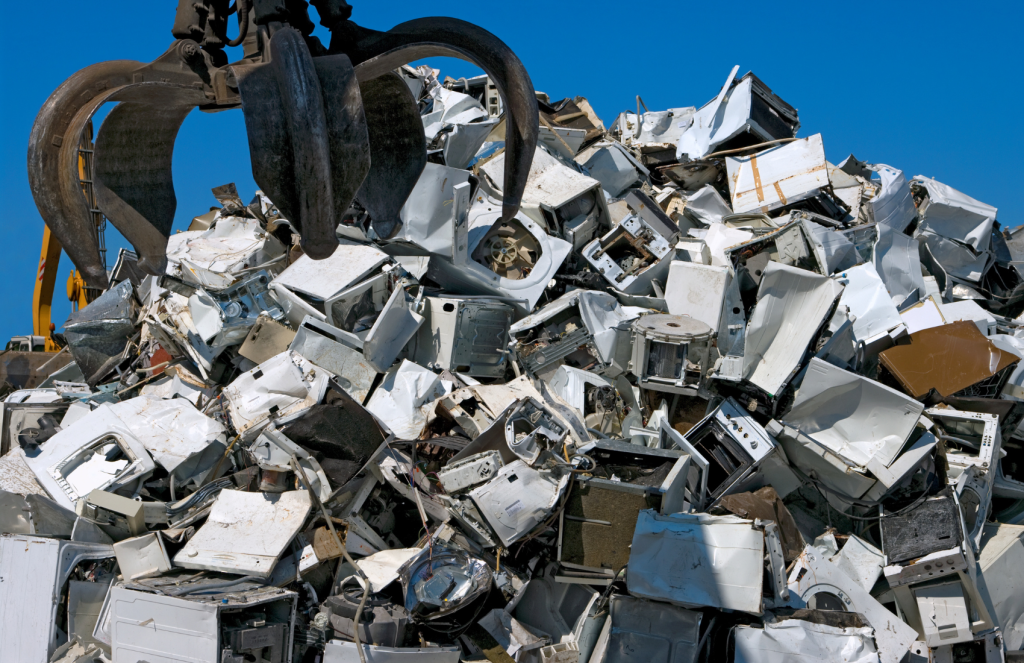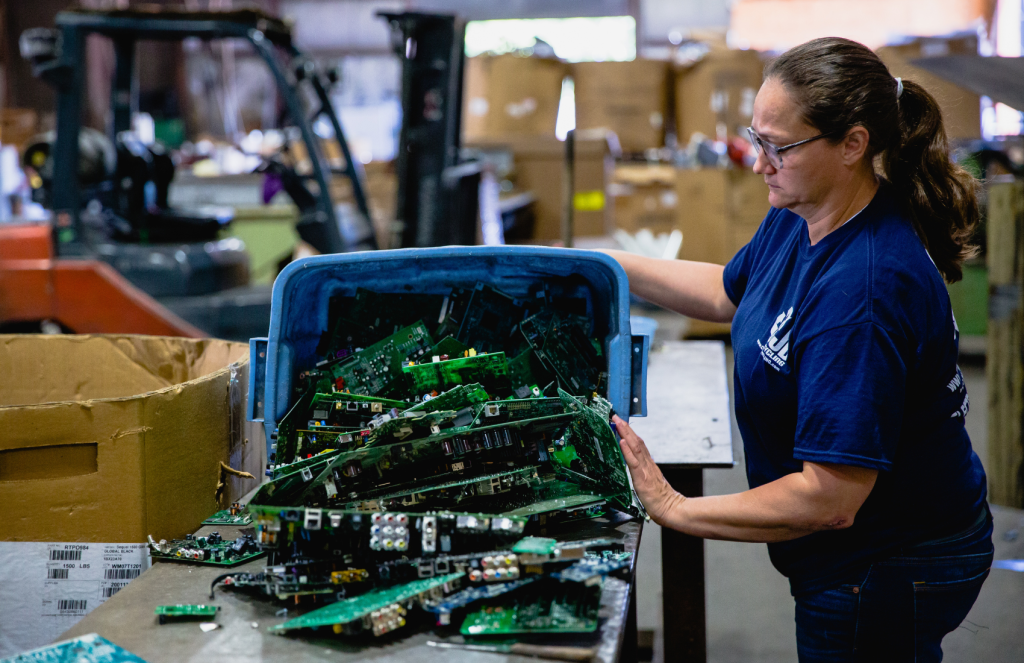The Hidden Environmental Crisis: How Electronic Waste is Reshaping Our Planet (And What We Can Do About It)
In our 15 years of electronic recycling at CJD E-Cycling, we’ve processed over 12,000 tons of discarded electronics, and what we’ve witnessed firsthand is nothing short of alarming. Every day, trucks arrive at our facility loaded with mountains of smartphones, laptops, televisions, and countless other devices that most people simply threw away without a second thought. But here’s what keeps us up at night: the impact of e-waste extends far beyond overflowing landfills—it’s quietly reshaping our planet’s future in ways most people never realize.
Electronic waste has become the world’s fastest-growing waste stream, and after seeing thousands of devices pass through our doors daily, we can tell you that the environmental consequences are more severe and immediate than most people understand. The relationship between electronic waste and environment isn’t just an abstract concern for future generations—it’s a crisis unfolding right now, in our communities, affecting the air we breathe and the water we drink.
The Staggering Scale of E-Waste: What We See Every Day
The Numbers That Keep Growing
When we started CJD E-Cycling in 2009, we thought we understood the scope of electronic waste. We were wrong. The world now generates over 54 million tons of e-waste annually—equivalent to the weight of 350 cruise ships—and this number increases by 3-5% every year. To put this in perspective, that’s roughly 6 kilograms of electronic waste for every person on Earth, every single year.
But statistics only tell part of the story. What really drives home the magnitude of this crisis is what we witness daily at our facility. Last Tuesday alone, we received 47 desktop computers from a single office closure, 23 CRT monitors from a school district, and over 200 smartphones from various sources. And that was just one day, at one facility, in one region.
What Actually Constitutes E-Waste
Through our years of operation, we’ve learned that people drastically underestimate what qualifies as electronic waste. Yes, everyone knows about old phones and computers, but the reality is much broader. In our daily processing, we handle:
- Obvious electronics: Computers, phones, tablets, televisions
- Kitchen appliances: Microwaves, coffee makers, toasters with digital displays
- Entertainment devices: Gaming consoles, DVD players, stereo systems
- Office equipment: Printers, fax machines, copiers, calculators
- Home improvement items: Digital thermostats, LED light bulbs, electronic door locks
- Fitness equipment: Treadmills with digital displays, fitness trackers, electronic scales
Last month, a family brought us what they thought was “just a few old electronics.” After our intake process, we’d catalogued 37 separate electronic items from their single household—many of which they hadn’t even considered e-waste.
The Shrinking Lifespan Problem
Perhaps the most troubling trend we’ve observed is the dramatically decreasing lifespan of electronic devices. In our early years, we regularly processed computers and televisions that were 8-10 years old. Today, the average device we receive is less than 3 years old, and smartphones often arrive in near-perfect working condition after just 18-24 months of use.
This isn’t just about changing technology—it’s about a fundamental shift in how we design, market, and dispose of electronics. The environmental cost of manufacturing a new smartphone is roughly equivalent to running it for 10 years, yet most people replace theirs every two years. We’ve processed phones that were traded in simply because a newer model offered a marginally better camera.
Environmental Impact: What We’ve Witnessed Firsthand
The Toxic Reality Hidden in Every Device
After 15 years of careful electronic dismantling, we can tell you that every single device contains materials that can devastate the environment if not handled properly. When people ask about the impact of e-waste, we often take them to our processing floor to see exactly what’s inside their “harmless” old laptop.
A typical smartphone contains over 40 different chemical elements, including lead, mercury, cadmium, and brominated flame retardants. These aren’t trace amounts—we’re talking about substantial quantities that require specialized handling protocols. When we dismantle a single CRT television, we recover approximately 4-8 pounds of lead from the glass alone. Multiply that by the hundreds of thousands of CRT monitors still being disposed of annually, and you begin to understand the scope of potential contamination.
The scariest part? We regularly encounter devices that were improperly disposed of before reaching us. Last year, we participated in a cleanup effort at a local illegal dumping site where dozens of old electronics had been abandoned. The soil testing revealed lead levels 400% above safe standards, and mercury contamination that extended 50 feet from the dump site. That contamination will persist for decades, affecting groundwater and local ecosystems.
Resource Depletion: The Hidden Cost of Convenience
The environmental impact extends far beyond toxic waste—it’s about the massive resource depletion required to manufacture new devices. Through our partnerships with precious metal recovery facilities, we’ve learned that the average smartphone contains more gold per ton than most gold mines. A single ton of smartphones yields approximately 300-350 grams of gold, compared to just 5-25 grams per ton of gold ore.
Yet we recover precious metals from less than 20% of the devices that should be recycled. The rest end up in landfills, where these valuable resources are permanently lost. From our processing data, we know that Americans dispose of over 416,000 smartphones daily. That’s more than $60 million worth of recoverable materials entering landfills every single day.
The mining required to replace these lost materials devastates landscapes worldwide. Cobalt mining for lithium-ion batteries has created environmental dead zones in the Democratic Republic of Congo. Rare earth element extraction in China has contaminated vast areas with radioactive waste. Every device that reaches our facility instead of a landfill represents a small victory against this destructive cycle.
Carbon Footprint: The Energy Equation
The relationship between electronic waste and environment includes a massive carbon component that most people never consider. Manufacturing electronics is incredibly energy-intensive—producing a single computer generates approximately 1,200 pounds of CO2 emissions. A smartphone’s manufacturing footprint equals about 185 pounds of CO2.
Through our facility’s energy monitoring, we’ve documented that properly recycling electronics requires 95% less energy than manufacturing new products from raw materials. When we process 100 smartphones, we prevent the equivalent carbon emissions of driving a car for 3,000 miles. Last year alone, our facility’s recycling activities prevented an estimated 2,400 tons of CO2 emissions—equivalent to taking 520 cars off the road for an entire year.
But here’s what really drives the point home: we’ve calculated that if just 50% of the electronics currently entering landfills were properly recycled instead, the carbon savings would equal removing 1.2 million cars from American roads annually.
Ecosystem Disruption: Real-World Consequences
The environmental damage from improper e-waste disposal isn’t theoretical—we’ve seen it firsthand through our community partnerships. Three years ago, we partnered with local environmental scientists to study a watershed near a former electronics dumping site. The results were sobering.
Water samples revealed elevated levels of heavy metals that had leached from discarded electronics over decades. Fish populations showed signs of heavy metal accumulation, and bird species that fed on aquatic life displayed developmental abnormalities linked to lead and mercury exposure. The contamination had traveled over two miles downstream from the original dump site.
This ecosystem disruption creates cascading effects that extend far beyond the immediate area. Contaminated fish affect the entire food web, from the bacteria that decompose organic matter to the larger predators that depend on aquatic ecosystems. We’ve documented similar contamination patterns at seven different sites in our region alone.
The Human Health Connection
Direct Health Impacts We’ve Observed
The connection between e-waste and human health became personal for our team when we discovered elevated lead levels in several of our newer employees during routine health screenings. This led us to completely overhaul our safety protocols and invest in advanced air filtration systems.
But our situation involves controlled, professional handling with extensive safety equipment. Communities near improper e-waste disposal sites face much more severe risks. Through our work with environmental health organizations, we’ve learned about children in e-waste processing regions showing elevated blood lead levels, respiratory problems from toxic fumes, and skin conditions from direct contact with contaminated materials.
The World Health Organization estimates that 18 million children worldwide work in waste processing industries, with many exposed to dangerous e-waste materials. These aren’t distant problems—we’ve documented cases of informal e-waste processing happening in residential areas less than 100 miles from our facility.
The Water Supply Connection
Perhaps the most concerning aspect of e-waste contamination is its impact on drinking water. Heavy metals from electronics don’t break down naturally—they accumulate in soil and groundwater over time. In our region, we’ve identified three municipal water systems that required expensive filtration upgrades specifically to address contamination traced back to electronics disposal sites.
The cost of cleaning contaminated water supplies far exceeds the cost of proper e-waste recycling. One nearby community spent $2.3 million upgrading their water treatment facility to address heavy metal contamination, while proper recycling of the electronics that caused the problem would have cost less than $50,000.
Success Stories: Positive Environmental Impact Through Proper E-Cycling
Transforming Corporate Waste Streams
Last year, we partnered with a regional healthcare system to completely overhaul their electronics disposal practices. Previously, they were spending $15,000 annually to have electronic waste hauled to landfills while purchasing millions of dollars in new equipment.
Our comprehensive audit revealed they were discarding over 400 functional devices annually—computers, monitors, and medical equipment that could be refurbished and redeployed. We developed a three-tier system: functional devices were refurbished for continued use, partially functional equipment was broken down for parts, and end-of-life electronics were properly recycled for material recovery.
The results exceeded everyone’s expectations. The healthcare system reduced their electronics disposal costs by 73%, recovered $89,000 worth of functional equipment, and prevented 23 tons of electronics from entering landfills. More importantly, they eliminated their contribution to local groundwater contamination while generating enough recovered materials to offset the environmental impact of 15% of their new equipment purchases.
Educational Impact: Changing Community Behavior
Three years ago, we launched a community education program after noticing that 67% of the electronics we received could have been properly recycled years earlier if people simply knew where to bring them. We partnered with local schools to create hands-on demonstrations showing students exactly what’s inside their devices and why proper disposal matters.
The program’s impact was immediate and measurable. In participating school districts, household e-waste recycling increased by 340% within six months. More importantly, students began influencing their families’ disposal decisions. We tracked a 25% reduction in electronics appearing in local household garbage collection, with most of those devices being redirected to appropriate recycling facilities.
One eighth-grader’s science project documented the heavy metal content in electronics found at illegal dump sites, ultimately leading to city council action that created three new official e-waste collection points. That single project prevented an estimated 150 tons of electronics from improper disposal over the following two years.
Innovation in Processing: Maximizing Recovery
Our commitment to environmental protection drove us to invest in advanced processing technologies that dramatically improve material recovery rates. Traditional e-waste processing recovers about 60-70% of valuable materials. Our upgraded facility now achieves 94% recovery rates through advanced separation technologies and strategic partnerships with specialized smelters.
This improvement translates directly to environmental benefits. Higher recovery rates mean fewer virgin materials need to be mined, less energy is consumed in manufacturing, and more toxic materials are safely contained instead of entering the environment. Our enhanced processing prevented the equivalent environmental impact of mining 847 tons of raw materials last year alone.
We’ve also pioneered a component-level refurbishment program that extends the useful life of electronic components by an average of 3-5 years. Circuit boards that would typically be shredded for metal recovery are instead tested, refurbished, and sold to repair facilities. This approach prevents the environmental cost of manufacturing replacement components while supporting a circular economy model.
Actionable Solutions for Businesses and Individuals
Best Practices We Recommend
After processing thousands of tons of electronics, we’ve identified the most effective strategies for minimizing environmental impact:
Device Lifecycle Management: The most environmentally beneficial approach starts before you even purchase new electronics. We recommend establishing clear criteria for device replacement—focusing on functionality rather than wanting the latest features. Our data shows that extending device lifespans by just one year reduces environmental impact by 20-30%.
Proper Data Security: One of the biggest barriers to responsible e-waste disposal is data security concerns. We’ve developed a comprehensive data destruction protocol that uses military-grade wiping software followed by physical drive destruction. Every client receives a certificate of data destruction, eliminating the fear that prevents many people from properly disposing of old devices.
Timing Your Disposal: Don’t store old electronics indefinitely. Devices degrade over time, making material recovery more difficult and less environmentally beneficial. We recommend disposing of electronics within 6-12 months after replacement.
How to Choose an E-Cycling Partner
Not all electronic recycling services provide the same environmental benefits. Through our industry involvement, we’ve identified critical questions you should ask any potential e-cycling partner:
Certification Verification: Legitimate e-cycling facilities should hold certifications from recognized organizations like R2 (Responsible Recycling) or e-Stewards. These certifications require annual audits and ensure that facilities meet strict environmental and data security standards.
Downstream Tracking: Ask where your electronics actually go after leaving the facility. Reputable recyclers can provide detailed information about their downstream partners and material recovery processes. Be wary of any service that can’t explain what happens to your devices after collection.
Local Processing: Shipping electronics across continents for processing defeats many environmental benefits. We prioritize partnerships with regional processing facilities to minimize transportation-related carbon emissions.
Prevention Strategies That Actually Work
The most environmentally beneficial electronics are the ones that never need to be recycled because they’re still in use. We’ve identified several strategies that dramatically extend device lifespans:
Proactive Maintenance: Simple actions like regular software updates, dust removal, and battery care can extend device lifespans by 2-3 years. We offer free device maintenance workshops that have helped participants extend their electronics’ useful life by an average of 18 months.
Strategic Purchasing: Buying refurbished electronics can reduce environmental impact by 70-80% compared to new devices. We maintain a certified refurbishment program that offers devices with environmental impact equivalent to just 23% of new manufacturing.
Corporate Programs: Businesses can implement device rotation programs that maximize the useful life of electronics across different applications. High-performance devices can be cascaded to less demanding applications rather than immediately retired.
Looking Forward: The Future of E-Waste and Environmental Protection
Emerging Technologies We’re Tracking
The e-waste landscape is evolving rapidly, and we’re actively monitoring technologies that could dramatically improve environmental outcomes. Advanced artificial intelligence is beginning to enable more precise material separation, potentially increasing recovery rates to 98-99%. Molecular-level recycling technologies could eventually allow complete material recovery with minimal energy input.
But the most promising development is the growing focus on circular design—electronics designed from the beginning for efficient disassembly and material recovery. We’re working with several manufacturers to test products designed with recycling in mind, and the early results suggest these approaches could reduce the environmental impact of electronics by 60-80%.
Policy Changes That Make a Difference
Legislation is slowly catching up to the e-waste crisis, and we’re seeing encouraging developments at state and federal levels. Extended producer responsibility laws that require manufacturers to fund recycling programs are expanding across the United States. These policies create economic incentives for better design while ensuring that recycling costs don’t fall solely on consumers and communities.
We’ve testified before state legislatures about the need for consistent e-waste policies that prioritize environmental protection over cost minimization. The most effective policies combine convenient collection systems with strict downstream processing requirements.
CJD’s Commitment to Continuous Improvement
Our environmental mission drives continuous investment in better technologies and processes. We’re currently planning a facility expansion that will double our processing capacity while reducing energy consumption by 35% through advanced automation and renewable energy integration.
More importantly, we’re committed to transparency about our environmental impact. We publish quarterly reports documenting our material recovery rates, energy consumption, and carbon footprint. This accountability ensures that our environmental claims are backed by measurable data rather than good intentions.
Taking Action: Your Role in Solving the E-Waste Crisis
The impact of e-waste on our environment is undeniable, but it’s not inevitable. Every decision to properly recycle electronics, extend device lifespans, or choose refurbished products over new ones contributes to meaningful environmental protection. The relationship between electronic waste and environment doesn’t have to be destructive—with proper handling, electronics recycling can actually contribute to environmental restoration.
After 15 years of witnessing both the problems and solutions in electronic waste management, we’re convinced that informed individual action creates collective environmental benefit. The hundreds of thousands of pounds of electronics we’ve properly processed represent millions of pounds of carbon emissions prevented, thousands of pounds of toxic materials safely contained, and vast quantities of virgin materials that didn’t need to be mined.
The environmental crisis created by electronic waste is real, immediate, and serious. But it’s also solvable. Every smartphone recycled instead of discarded, every laptop refurbished instead of replaced, and every business that implements responsible electronics management contributes to environmental protection that benefits everyone.
Ready to make a difference? Contact CJD E-Cycling today to learn how we can help you minimize your electronics’ environmental impact while ensuring complete data security. Together, we can transform the relationship between technology and environmental health—one device at a time.
Contact CJD E-Cycling: Visit cjdecycling.com or call us to schedule your electronics pickup and take the first step toward responsible environmental stewardship. Your electronics have value beyond their original purpose—let us help you unlock their environmental benefits.


